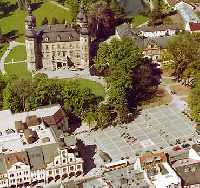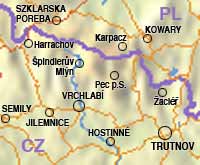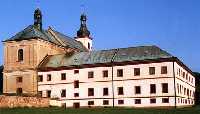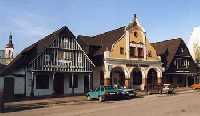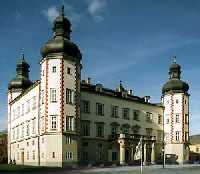|
Today is:
Thursday 3.07.2025
Weather

©2008 Mediapool
|
Zip code: 543 01
Number of inhabitants: ca. 13300
Elevation: 450 m above the sea level info@krkonose.eu
www.krkonose.eu The community is member of union:
The Krkonose Mts. - Union of Municipalities
The picturesque mountain town in the upper part of the Labe River. It is called the" Gate to the Giant Mountains". Vrchlabí is an ideal starting point into the central part of the Giant Mountains.
History:
The first mention of the village Vrchlabi in the authority sources appears in 1359 when Lanov vicar Henry brings vicar Herman to Vrchlabi. To begin with the village belong to noblemen Hasek from Vrchlabi who were settled in a fortified settlement constructed from wood and protected by a moat.
Several aristocratic families took turns in its possession. A significant change in the history of Vrchlabi was in 1533 when Carinthian aristocrat Christopher from Gendorf got in possession of the demense. Through a brevet of October 6, king Ferdinant I., who Gendorf served as the supreme commissioner of kingdom of Bohemia, bestowed town rights on Vrchlabi. The old village sprawled into a free mining town. Christopher from Gendorf established the biggest and most advanced iron works in Bohemia.
The advanced smelting works was later used by a future generalissimo Albrech from Wallenstein who bought Vrchlabi demesne in 1624 at the beginning of the Thirty Years' War. manufacture for production of rifles supplied Wallenstein's army and emplyed a large number of craftsmen from different professions.
In 1635 after Albrech from Wallenstein had been murdered, emperor Ferdinand II. presented the confiscated town as well as the demesne to Rudolph, a count from Morzin. From 2nd half of 17th century processing of flax was becoming more and more significant in town existence. Spinning and weaving replaced the mining tradition in 18th century.
Wars for Silesia waged by Maria Theresa on king Frederick II. were disturbing the life of townsmen since the forties of 18th century a further on the villain rebellion that was lead by Lanov village mayor Anthony Lahr. Up to the middle of 19th century when spinning and weaving remained a domestic handicraft, new bleaching grounds and textile fabrics printing plants were established. In the second half of 19th century Vrchlabi was among the most industrial centers of Austria-Hungary monarchy. Furthermore during the period up to the First World War the dominant importance of the textile industry was increased by printing plants, dye-works and bandage material works Hartmann and Kleining. During the period after the post-war crisis new professions gained ground - manufacturing of automobile bodies (company Th. Peter) and cables (company K.Löwit).
In 1938 through Munich accord Vrchlabi was annexed to Nazi Germany as a part of so called Sudeten district. The Allies victory and transfer of Germans from the border region in 1945-1946 gave raise to a flood of new Czech population to Vrchlabi. The establishment and stabilization of the communist regime after 1948 made the natural town development impossible for a long time. Only after the Velvet revolution in 1989 the town entered the period of undreamed-of flowering as an actual gateway to the highest mountains of the Czech Republic.
|
|



